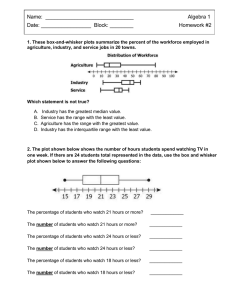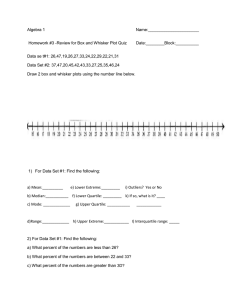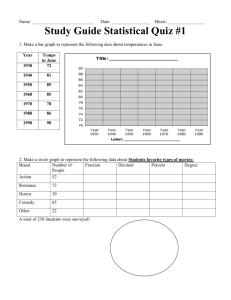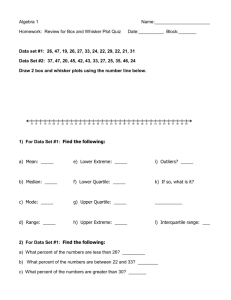Human Box Plot
advertisement
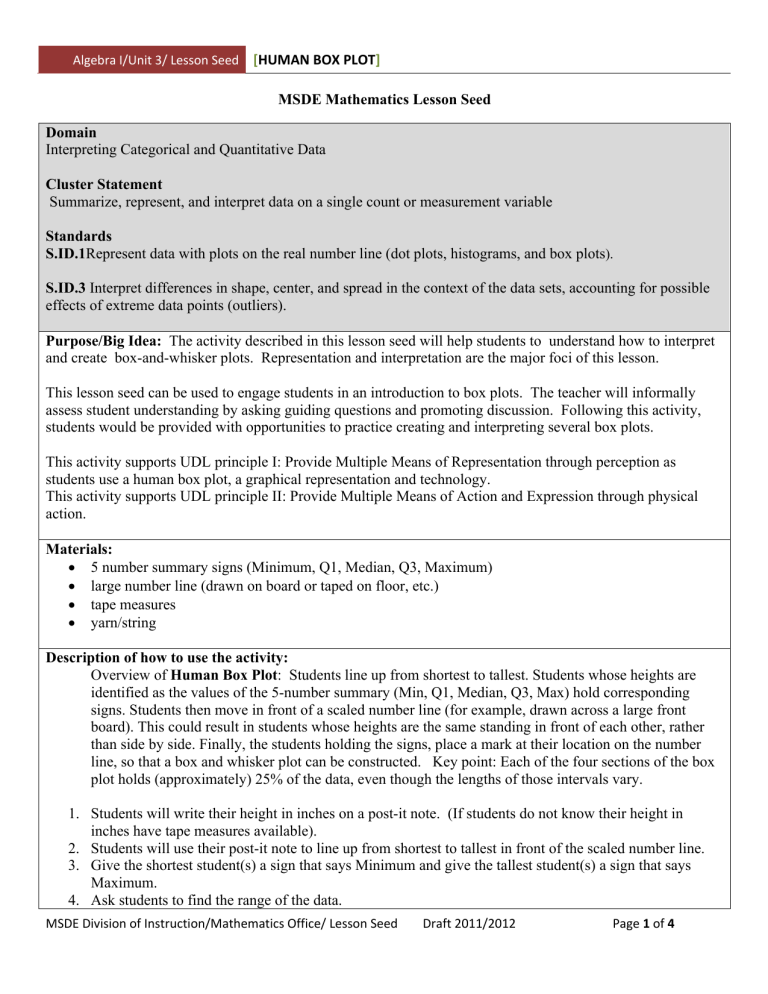
Algebra I/Unit 3/ Lesson Seed [HUMAN BOX PLOT] MSDE Mathematics Lesson Seed Domain Interpreting Categorical and Quantitative Data Cluster Statement Summarize, represent, and interpret data on a single count or measurement variable Standards S.ID.1Represent data with plots on the real number line (dot plots, histograms, and box plots). S.ID.3 Interpret differences in shape, center, and spread in the context of the data sets, accounting for possible effects of extreme data points (outliers). Purpose/Big Idea: The activity described in this lesson seed will help students to understand how to interpret and create box-and-whisker plots. Representation and interpretation are the major foci of this lesson. This lesson seed can be used to engage students in an introduction to box plots. The teacher will informally assess student understanding by asking guiding questions and promoting discussion. Following this activity, students would be provided with opportunities to practice creating and interpreting several box plots. This activity supports UDL principle I: Provide Multiple Means of Representation through perception as students use a human box plot, a graphical representation and technology. This activity supports UDL principle II: Provide Multiple Means of Action and Expression through physical action. Materials: • 5 number summary signs (Minimum, Q1, Median, Q3, Maximum) • large number line (drawn on board or taped on floor, etc.) • tape measures • yarn/string Description of how to use the activity: Overview of Human Box Plot: Students line up from shortest to tallest. Students whose heights are identified as the values of the 5-number summary (Min, Q1, Median, Q3, Max) hold corresponding signs. Students then move in front of a scaled number line (for example, drawn across a large front board). This could result in students whose heights are the same standing in front of each other, rather than side by side. Finally, the students holding the signs, place a mark at their location on the number line, so that a box and whisker plot can be constructed. Key point: Each of the four sections of the box plot holds (approximately) 25% of the data, even though the lengths of those intervals vary. 1. Students will write their height in inches on a post-it note. (If students do not know their height in inches have tape measures available). 2. Students will use their post-it note to line up from shortest to tallest in front of the scaled number line. 3. Give the shortest student(s) a sign that says Minimum and give the tallest student(s) a sign that says Maximum. 4. Ask students to find the range of the data. MSDE Division of Instruction/Mathematics Office/ Lesson Seed Draft 2011/2012 Page 1 of 4 Algebra I/Unit 3/ Lesson Seed [HUMAN BOX PLOT] 5. Record the min, max, and range on the board. 6. Count total number of students. 7. Count off from the ends (both say 1, both say 2, etc.) of the line inward to find the median. If there is an even number of students in the class, it will be necessary to average the two middle heights. 8. Write the median on the board and introduce the tern 50th percentile. Prompt students to make realworld connections to the term (i.e., a half-dollar represents 50 cents, 50th percentile in reference to height and weight charts, etc.) 9. Instruct students on either side of the median to repeat step 7 in order to find Q1 andQ3. 10. Determine which student represents the Q1. Provide that student with a sign that says “Q1.” 11. Determine which student represents the Q3. Provide that student with a sign that says “Q3.” 12. Record QI and Q3 on the board. 13. Discuss other representations (first quartile (Q1)/third quartile (Q3), 25th percentile/75th percentile). The median would be Q2; however it is referred to as the median because of its importance. 14. We now have recorded the 5 number summary. 15. Provide a long piece of yarn to the student holding the “Q3” sign to keep in his/her hand. 16. Pass the yarn to the student holding the “Q1” sign. This student should hold the yarn with both hands. 17. Then, loop the yarn back to the student with the “Q3” sign to hold in his/her other hand to create a box that includes all the students between Q1 and Q3. The data between Q1 and Q3 is in the “box”. Explain that they have made a human box-and-whisker plot. 18. Discuss inter-quartile range (IQR) 19. Discuss outliers if applicable. Q1 – 1.5(IQR) or Q3 + 1.5(IQR) 20. Use the attached template to decide on a scale and create paper versions of the human box plot. 21. Show a box-and-whisker plot with graphing calculator using the class data. Guiding Questions: • Where should you stand if you and another student have the same height? • How do we find the median if we have two people left in the middle? • Why do you think the median is called the 50th percentile? • How many students are between the: o Minimum and lower quartile (Q1)? o Lower quartile(Q1) and median? o Median and upper quartile(Q3)? o Upper quartile(Q3) and the maximum? o Minimum and the maximum? o Lower quartile(Q1) and upper quartile(Q3)? • What percent of the data is represented between the: o Minimum and lower quartile(Q1)? o Lower quartile(Q1) and median? o Median and upper quartile(Q3)? o Upper quartile(Q3) and the maximum? o Minimum and the maximum? o Lower quartile(Q1) and upper quartile(Q3)? • How many students are included in the box? How does this compare to the total number of students in the class? • How does the number of students contained in each quartile relate to the visual representation of the box plot? MSDE Division of Instruction/Mathematics Office/ Lesson Seed Draft 2011/2012 Page 2 of 4 Algebra I/Unit 3/ Lesson Seed [HUMAN BOX PLOT] Modifications for ELLs and Struggling Learners: • Emphasize the different vocabulary terms that can used interchangeably. Consider having students sort and classify terms according to their meaning as a follow-up activity to assess understanding. • Post vocabulary words on a word wall for future reference. • Connect vocabulary terms with real-life experiences or to their Native Language(s). • Count out loud to find the median, Q1 and Q3 to help keep students organized. • Emphasize connections between multiple representations Extensions: • Discuss the implication of outliers. • Compare the class box-and-whisker plot to another sample of student heights and discuss features of the two graphs. MSDE Division of Instruction/Mathematics Office/ Lesson Seed Draft 2011/2012 Page 3 of 4 Algebra I/Unit 3/ Lesson Seed [HUMAN BOX PLOT] MSDE Division of Instruction/Mathematics Office/ Lesson Seed Draft 2011/2012 Page 4 of 4
